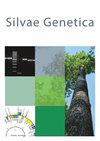沙棘树每朵雄花花粉量的变化
IF 1
4区 农林科学
Q3 FORESTRY
引用次数: 0
摘要
均匀增加每个克隆的散粉数量对于保持克隆种子园的高遗传变异非常重要。因此,不仅要确定每棵树的雄花数量,还要确定每个克隆中每朵雄花的花粉量。在本研究中,利用 21 个 Abies sachalinensis 克隆进行了为期 3 年的研究,调查了雄花鲜重(FW)是否存在年变异,以及每朵雄花的花粉重量(WP)在相同树龄或不同树龄下的克隆和年变异以及柱头变异。结果表明,不同克隆的花粉重量和雄花重量每年都有显著差异,花粉重量和雄花重量之间的关系每年都呈线性显著关系。可湿性粉剂也表现出明显的年度变化,而再生粉剂也有明显的变化。在 2 年或 3 年的数据中,WP 的克隆重复性为 0.37-0.47,克隆、年份和植株随机效应的广义线性混合模型表明,克隆效应比其他效应对 WP 的影响更大。这些结果表明,A. sachalinensis 的可湿性是一个受克隆特征影响较大的性状;因此,在使用种子果园时,有必要对每个克隆的这一性状进行鉴定。本文章由计算机程序翻译,如有差异,请以英文原文为准。
Variation in the amount of pollen per male flower on Abies sachalinensis
It is important to evenly increase the amount of scattered pollen per clone for maintaining high genetic variation in clonal seed orchards. It is thus imperative to determine not only the number of male flowers per tree, but also the amount of pollen per male flower in each clone. In this study, the existence of annual variation on the fresh weight of male flowers (FW) and the clonal and annual variation, and ramets’ variation with the same or different tree ages on the weight of pollen per male flower (WP) were investigated using 21 Abies sachalinensis clones for 3 years. The results indicated that there were significant differences in FW and WP among clones each year and the relationships between FW and WP were linearly significant for every year. WP also showed significant annual variation, while the re was also significant variation in ramets. The clonal repeatability regarding WP was 0.37—0.47 for data obtained for 2 or 3 years and the generalized linear mixed models with the random effects of clone, year, and ramet indicated that the effect of clone more strongly affected WP than other effects. These results suggested that WP on A. sachalinensis is a trait that is considerably influenced by clonal characteristics; there is thus a need to characterize this trait in each clone when using seed orchards.
求助全文
通过发布文献求助,成功后即可免费获取论文全文。
去求助
来源期刊

Silvae Genetica
农林科学-林学
CiteScore
2.20
自引率
10.00%
发文量
10
审稿时长
3 months
期刊介绍:
Silvae Genetica is an international peer reviewed journal with more than 65 year tradition and experience in all fields of theoretical and applied Forest Genetics and Tree breeding. It continues "Zeitschrift für Forstgenetik und Forstpflanzenzüchtung" (Journal of Forest Genetics and Forest Tree Breeding) founded by W. LANGNER in 1951.
 求助内容:
求助内容: 应助结果提醒方式:
应助结果提醒方式:


